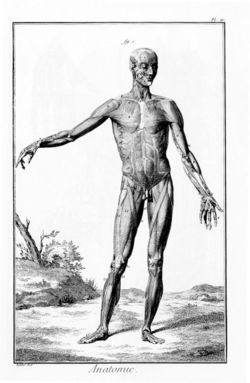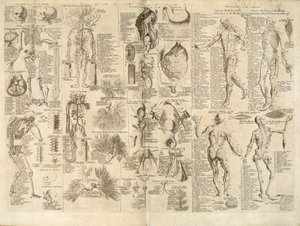Anatomy
2007 Schools Wikipedia Selection. Related subjects: General Biology
Anatomy (from the Greek ἀνατομία anatomia, from ἀνατέμνειν anatemnein, to cut up, cut open), is the branch of biology that deals with the structure and organization of living things. It can be divided into animal anatomy ( zootomy) and plant anatomy (phytotomy). Furthermore, anatomy can be covered either regionally or systemically, that is, studying anatomy by bodily regions such as the head and chest for the former, or studying by specific systems, such as the nervous or respiratory systems for the latter. Major branches of anatomy include comparative anatomy, histology and human anatomy.
Human anatomy
From a utilitarian point of view the study of humans is the most important division of special anatomy, and this human anatomy may be approached from different points of view.
From that of Medicine it consists of a knowledge of the exact form, position, size and relationship of the various structures of the healthy human body, and to this study the term descriptive or topographical human anatomy is given, though it is often, less happily, spoken of as anthropotomy.
So intricate is the human body that only a small number of professional human anatomists, after years of patient observation, are masters of its details; most of them specialize on certain parts, such as the brain or viscera, contenting themselves with a good working knowledge of the rest.
Topographical anatomy must be learned by repeated dissection and inspection of dead human bodies. It is no more a science than a pilot's knowledge is, and, like that knowledge, must be exact and available in moments of emergency.
From the morphological point of view, however, human anatomy is a scientific and fascinating study, having for its object the discovery of the causes which have brought about the existing structure of humans, and needing a knowledge of the allied sciences of embryology or developmental biology, phylogeny, and histology.
Pathological anatomy (or morbid anatomy) is the study of diseased organs, while sections of normal anatomy, applied to various purposes, receive special names such as medical, surgical, gynaecological, artistic and superficial anatomy. The comparison of the anatomy of different races of humans is part of the science of physical anthropology or anthropological anatomy. In the present edition of this work the subject of anatomy is treated systematically rather than topographically. Each anatomical article contains first a description of the structures of an organ or system (such as nerves, arteries, heart, and so forth), as it is found in humans; this is followed by an account of the development (embryology) and comparative anatomy (morphology), as far as vertebrate animals are concerned; but only those parts of the lower animals which are of interest in explaining human body structure are here dealt with. The articles have a twofold purpose; first, to give enough details of structure to make the articles on physiology, surgery, medicine and pathology intelligible; and, second, to give the non-expert inquirer, or the worker in some other branch of science, the chief theories on which the modern scientific groundwork of anatomy is built......

